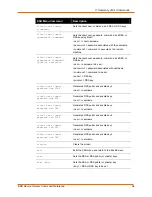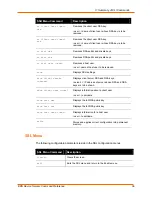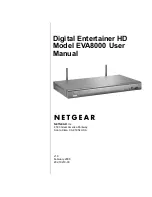
4: Configuration Using XML
EDS Device Servers Command Reference
46
The element's content is everything that appears between the start tag and end tag,
including text and other (child) elements.
In addition to content, an element can contain attributes — name-value pairs included in
the start tag after the element name. Attribute values must always be quoted, using
single or double quotes. Each attribute name should appear only once in an element.
The Evolution OS™ uses these attributes to differentiate and group configuration
settings.
Records, Groups, Items, and Values
A group is a logical grouping of config parameters and must contain one or more item
elements. It takes the name and may take an instance.
A name identifies the group, item, or value. It is always quoted (as are all XML
attributes). For example, a group that contains serial port parameters has the name
“line”.
An instance identifies which of several instances is being addressed. It is always
quoted. For example, the serial port name might have the instance “1” to indicate
serial port 1 or “2” to specify serial port 2.
An item is a specific grouping of configuration parameters relevant to its parent group. An
item takes the name attribute and must contain one or more value elements. For
example, the line group might have parameters such as baud rate, data bits, and parity.
A value may specify the value of a configuration parameter. It may take the name
attribute. In our example, a value of 9600 might be specified for baud rate, 7 may be
specified for data bits, and even may be specified for parity.
The following figures show color-coded examples of XML pages that use records,
groups, items, and values.
Figure 4-2. XML Group Example
<?xml version=”1.0” standalone=”yes”?>
<configrecord>
<configgroup name = “serial command mode” instance = “1”>
<configitem name = “mode serial string”>
<value>disable</value>
</configitem>
</configgroup>
</configrecord>
Figure 4-3. XML Example with Multiple Named Values
<?xml version=”1.0” standalone=”yes”?>
<configgroup name = "ssh server">
<configitem name = "host rsa keys">
<value name = "public key"></value>
<value name = "private key"></value>
</configitem>
</configgroup>
















































